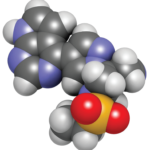Active Inflammatory Arthritis:
- For patients well controlled on hydroxychloroquine or chloroquine, this disease-modifying anti-rheumatic drug (DMARD) should be continued, when available; when unable to access (including in patients with active or newly diagnosed disease), switching to a different conventional synthetic DMARD (csDMARD) (either as monotherapy or as part of combination therapy) should be considered (M/H).
- For patients well controlled on an IL-6 inhibitor, this DMARD should be continued, when available; when unable to access the agent, switching to a different biologic should be considered (M). The panel noted uncertainty regarding the use of JAK inhibitors in this situation.
- For patients with moderate to high disease activity despite optimal csDMARDs, biologics may be started (H). The panel noted uncertainty regarding the use of JAK inhibitors in this situation.
- For active or newly diagnosed inflammatory arthritis, csDMARDs may be started or switched (M).
- If indicated, low-dose glucocorticoids (≤10 mg prednisone equivalent) or NSAIDs may be started (M/H).
Other Rheumatic Diseases:
- In patients with systemic inflammatory or vital organ-threatening disease (e.g., lupus nephritis or vasculitis), high-dose glucocorticoids or immunosuppressants may be initiated (M).
- In patients with newly diagnosed Sjögren’s syndrome, given the paucity of data proving efficacy, hydroxychloroquine or chloroquine should not be started (M).
For ongoing treatment of stable patients following SARS-CoV-2 exposure (without symptoms related to COVID-19):
- Hydroxychloroquine, sulfasalazine and NSAIDs may be continued (M/H).
- Other immunosuppressants, non-IL-6 biologics and JAK inhibitors should be stopped temporarily, pending a negative test result for COVID-19 or after two weeks of symptom-free observation (M). The panel noted uncertainty regarding temporarily stopping methotrexate or leflunomide in this situation.
- In select circumstances, as part of a shared decision-making process, IL-6 inhibitors may be continued (M).
For rheumatic disease treatment in the context of documented or presumptive COVID-19 infection:
- Regardless of COVID-19 severity, antimalarial therapies (hydroxychloroquine or chloroquine) may be continued, but sulfasalazine, methotrexate, leflunomide, immunosuppressants, non-IL-6 biologics and JAK inhibitors should be stopped or held (M/H).
- For patients with severe respiratory symptoms, NSAIDs should be stopped (M). The panel demonstrated low consensus with regard to stopping NSAIDs in the absence of severe symptoms.
- In select circumstances, as part of a shared decision-making process, IL-6 inhibitors may be continued (M).
Reinitiating treatment following COVID-19:
- For patients with uncomplicated COVID-19 infections (characterized by mild or no pneumonia and treated in the ambulatory setting or via self-quarantine), consideration may be given to restarting rheumatic disease treatments (e.g., DMARDs, immunosuppressants, biologics and JAK inhibitors) within seven to 14 days of symptom resolution. For patients who have a positive PCR test for SARS-CoV-2, but are (and remain) asymptomatic, consideration may be given to restarting rheumatic disease treatments (e.g., DMARDs, immunosuppressants, biologics and JAK inhibitors) 10 to 17 days after the PCR test is reported as positive (H).
- Decisions regarding the timing of reinitiating rheumatic disease therapies in patients recovering from more severe COVID-19-related illness should be made on a case-by-case basis (H).
Bottom Line
These statements are not intended to replace clinical judgment. Modifications made to treatment plans, particularly in complex rheumatic disease patients, are highly disease, patient, geography and time specific, and, therefore, must be individualized as part of a shared decision-making process. This guidance is provided as part of a living document, recognizing rapidly evolving evidence and the anticipated need for frequent updates as such evidence becomes available.



